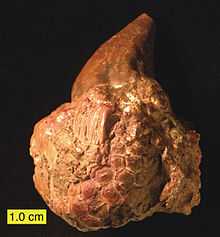Platyceratidae
From Wikipedia, the free encyclopedia
| Platyceratidae Temporal range: Middle Ordovician–Permian[1][2] | |
|---|---|
 | |
| Conical platyceratid gastropod (Palaeocapulus acutirostre) attached to a crinoid (Mississippian of Ohio) | |
| Scientific classification | |
| Kingdom: | Animalia |
| Phylum: | Mollusca |
| Class: | Gastropoda |
| Order: | incertae sedis |
| Superfamily: | †Platyceratoidea Hall, 1879 |
| Family: | †Platyceratidae Hall, 1879 |
Platyceratidae is an extinct family of Paleozoic sea snails, marine gastropod mollusks. This family may belong in the Patellogastropoda or the Neritimorpha.[2] The platyceratid gastropods are known for the complex symbiotic relationships they had with crinoids.[3]
This is the only family in the superfamily Platyceratoidea.
Genera
- Platyceras Conrad, 1840 - type genus
- Palaeocapulus Grabau & Shimer, 1909
References
- ↑ Wagner, P. J. (2004). "Phylogenetic Relationships of the Earliest Anisostrophically Coiled Gastropods". Smithsonian Contributions to Paleobiology 88: 1–152. doi:10.5479/si.00810266.88.1.
- ↑ 2.0 2.1 Sutton, M. D.; Briggs, D. E. G.; Siveter, D. J.; Siveter, D. J. (2006). "Fossilized soft tissues in a Silurian platyceratid gastropod". Proceedings of the Royal Society B: Biological Sciences 273 (1590): 1039. doi:10.1098/rspb.2005.3403.
- ↑ Baumiller T. K. (2003). "Evaluating the interaction between platyceratid gastropods and crinoids; a cost-benefit approach". Palaeogeography, Palaeoclimatology, Palaeoecology 201(3-4): 199-209. doi:10.1016/S0031-0182(03)00625-4.
.JPG)
Cross-section of a Lower Carboniferous crinoid with an in situ parasitic platyceratid gastropod.
| Wikimedia Commons has media related to Platyceratidae. |
This article is issued from Wikipedia. The text is available under the Creative Commons Attribution/Share Alike; additional terms may apply for the media files.